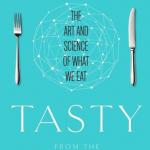Tasty: the Art and Science of What We Eat

Early on in this excellent and absorbing investigation into the origin and nature of taste, John McQuaid promises that the book will be “a brief biography of flavor. The narrative begins at the dawn of life on earth . . . and explores the structure of this unique sensation, from its molecular building blocks through more sophisticated levels of body, brain, and mind.” If I imagined a whiff of hubris in McQuaid’s ambitions, the Pulitzer Prize-winning journalist certainly proved himself up to the task, distilling and presenting in lively and entertaining prose a dizzying amount of scientific and cultural research throughout. I’m not sure I would have ever made the connection between President George H.W. Bush’s famous dislike of broccoli and the survival instincts of a 500-million-year-old sea anemone, but McQuaid skillfully connects some very disparate dots.
On one hand, McQuaid provides evidence that aversion to bitterness, whether experienced by a simple life form or a more evolved one such as the Bush family, is a way of testing and rejecting potential toxins. Nevertheless, a taste for bitterness grew as humans evolved, making it as essential to our palates as sweet, sour, and salt. Cauliflower, Brussels sprouts, radishes, cocoa, beer, and coffee all have appealing bitter qualities. McQuaid suggests that a small percentage of “bitter-sensitive” humans present in the many small migratory groups that spread out across the earth after the last ice age were in no small way responsible for mankind’s survival by testing bitter plants for toxins. Intriguingly, they embraced “sprigs atop twisted roots: plants from the genus Brassica, the wild ancestors of broccoli and mustard. What these lacked in tastiness, they made up for in nutrition [and they] stimulate the immune system.” Whether investigating our seemingly irrational attraction to insanely hot chiles, the history-changing effects of fermentation, or how the brain reacts to sweetness, McQuaid’s quest in this book is to debunk the prejudice held for centuries by the learned that of all the senses that of taste is the least consequential.
In the chapter on sugar and sweetness, “The Seduction,’’ the author writes, “Like ancient Greeks, modern scientists often dismissed the pleasures of food, and pleasure generally. . . . They believed it was the feelings of discomfort that really mattered.” In fact, relatively recent research done by Kent Berridge over the last 30 years found pleasure centers he termed “hedonic hotspots . . . tiny clumps of neurons . . . are the only brain structures known that directly cause pleasure.” McQuaid says Berridge’s triangular theory of how these clumps of neurons work together “applies particularly to taste and to flavor. . . . Wanting is a state of desire and heightened focus before food is eaten. Liking is the pleasure of a good taste. . . . Wanting and liking work in tandem to forge learning . . . learning where the tastiest food is and how to get it.”
McQuaid’s presentation of the scientific research is fascinating, but what elevates “Tasty’’ is the author’s inclusion of history, culture, and art. Before launching into the scientific research into sweetness, he tells the 2,500-year-old story of the two Indian brothers who stopped their caravan to give a sweet treat to a beggar by the side of the road. The beggar was none other than Siddhartha Guatama, the Buddha. Because his spiritual evolution had freed him from desire (eliminating one side of Berridge’s triangular theory), the Buddha was able to devote himself to the simple enjoyment of his cake.
My favorite chapter was “The DNA of Deliciousness,’’ and the author admits, “Deliciousness is a slippery concept. It is an ideal, something chefs aspire to create and everyone wants to experience.” He writes of the discovery in 1907 of umami and its recognition as a basic taste and how 90 years later a restaurant entrepreneur named Adam Fleishman was eating an In-n-Out burger in Los Angeles and obsessing over umami. Like a mad scientist he retreated to his home and spent countless hours mashing together strange ingredients until he came up with the perfect “umami burger’’ (to my mind one of the best burgers that’s ever met my mouth). For all the wonderful, eclectic information McQuaid brings together in “Tasty,’’ I’m sure he’d be the first to admit that some tastes remain elusive and mysterious and beyond the grasp of science. Fleishman’s Umami Burger is delicious because . . . well, it just is.
Kent Black is an editor and writer who lives in New Mexico.
